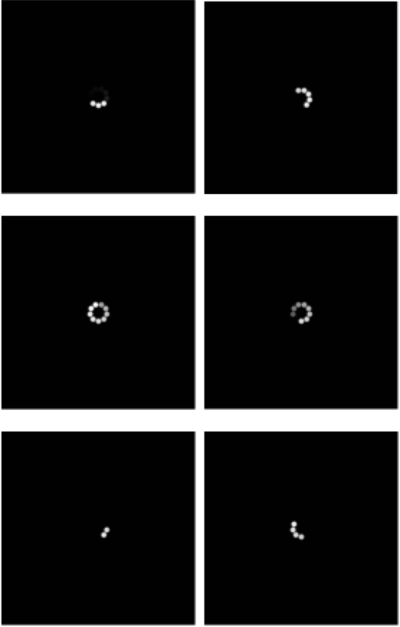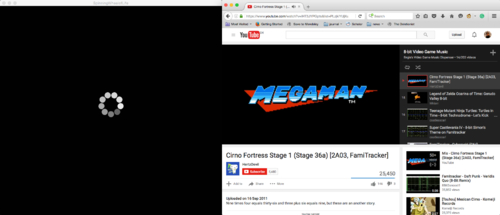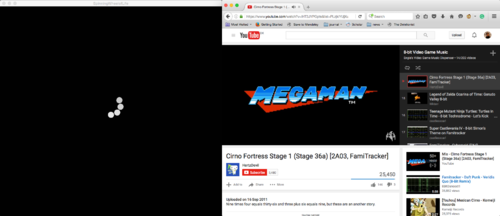Difference between revisions of "Exe0.2 Winnie Soon"
| (63 intermediate revisions by the same user not shown) | |||
| Line 1: | Line 1: | ||
====The Spinning Wheel of Life ( | ====The Spinning Wheel of Life (work-in-progress)==== | ||
[[File:Animatedthrobber.gif]] | |||
This work draws upon my previous working article from exe0.1- [[http://softwarestudies.projects.cavi.au.dk/index.php/Exe0.1_Winnie_Soon At the time of execution: throbber.start()]] | This work draws upon my previous working article from exe0.1- [[http://softwarestudies.projects.cavi.au.dk/index.php/Exe0.1_Winnie_Soon At the time of execution: throbber.start()]] | ||
====Screenshots:==== | ====Screenshots:==== | ||
[[File:throbbers.png|none|400px|left|]] | |||
[[File:throbber01.png|none|500px|left|]] | [[File:throbber01.png|none|500px|left|]] | ||
[[File:throbber02.png|none|500px|left|]] | [[File:throbber02.png|none|500px|left|]] | ||
====Description:==== | |||
The project challenges the perception of a throbber that is usually understood as a transitional object, waiting for content delivers on a screen. By having a music stream that runs in the background, the throbber appears not because of waiting for data arrival, but, instead, it spins as the machine receives data and stores them in a buffer for immediate retrieval. There are micro processes that are merely being noticed. | |||
Commonly, a throbber expresses the unknowable waiting time that spins at a constant rate. In ''The Spinning Wheel of Life,'' the project explores a different dimension of time - the "microtemporality" of data transmission and data processing through subverting the usual functioning of a throbber<ref>Ernst, W. (2013). Digital Memeory and the Archive. Minneapolis: University of Minnesota Press</ref>. Beyond the negative connotations of waitings, frustrations and annoyance, how might we reflect on a throbber, also known as the spinning wheel of death, that has become a cultural object and used commonly in contemporary software culture? | |||
A data stream transverses at different speeds and through various sites across network connections, devices and nodes. The work reveals the microtemporality of a data stream that is not often made visible to us. Instead of presenting a throbber that spins at a constant speed, the project makes apparent the real-time network traffic at a microscopic level through the display of repetitive but different tempo of ellipses. Since packets arrive at multiple time and space, and sometimes a huge amount of packets arrive at almost the same time (the time is down to milliseconds), the visual throbber yields an unusual and uneven spinning wheel—from having just a few ellipses to a full throbber with all the ellipses displayed brightly. The work presents an ongoing operative processing, addressing the microtemporality of its inter-actions that underpin the networked logic of contemporary software culture. | |||
Data is transmitted extremely fast and in vast quantity in contemporary software culture, and such conditions do not favour a close examination of computational processes that happen behind a digital and cultural object like a throbber. On the contrary, David Berry suggests, "if the speeds of the computers were slowed down, we would be able to watch our computers tick through their actions in real time". <ref>Berry, David M. The Philosophy of Software Code and Mediation in the Digital Age. Basingstoke: Palgrave Macmillan, 2011. elektronisk materiale, 38.</ref> The work takes the strategy of slowing down the running code and selecting a smaller stream source so as to capture the background processes of synchronisation, operations and executions. A stream does not always flow smoothly, uninterruptedly and continuously, as Florian Sprenger argues, a stream is a metaphor, he says, "There is no stream in digital networks".<ref>Sprenger, Florian. The Politics of Micro-Decisions: Edward Snowden, Net Neutrality, and the Architectures of the Internet. Lüneburg: meson press, 2015, 88-99</ref> | |||
A stream contains a series of chopped packets that produce differences and rhythms through their transmission journeys. The throbber in ''The Spinning Wheel of Life'' is an enactment of real-time data processing, but the process is more than a mere transfer. As Wolfgang Ernst reminds, buffering is a coupling of storage and transfer. <ref>Ernst, Wolfgang. "Dis/Continuities: Does the Archive Become Metaphorical in Multi-Media Space?". In New Media, Old Media : A History and Theory Reader, edited by Wendy Hui Kyong Chun and Thomas Keenan, x, 418 sider. New York ; London: Routledge, 2006 </ref> While data are regularly read by a machine, packets are irregularly written in a buffer. A buffer refers to temporary memory in which writing and reading of data are processed at different rates. <ref>Laplante, Philip A. Dictionary of Computer Science, Engineering and Technology CRC Press, 2000.</ref> More importantly, viewers are not watching or listening to the content as data arrives. Instead, they are experiencing the processed data that are being written and read in the buffer. At a microscopic level, there is latency between data arrival, data storage and data processing that are not apparent to us. | |||
''The Spinning Wheel of Life'' addresses executions and micro-decisions (Sprenger, 2015) occur along the journey of network transmission and data processing. There are different rates, tempo, pulses, pauses and rhythms at multiple scales - from the operations of the CPU to network routers, from the transmissions of senders to receivers, from the writing to the reading of buffers, and from continuous streams to discontinuous packets. ''The Spinning Wheel of Life'' is a reflection of the microtemporal complexity of data processing, constantly rendering the now in this pervasive, timely and networked conditions. Time is an essential element in contemporary software culture as it governs how a signal is processed, how data is transmitted and how micro-decisions are made.[1] This microtemporality is "time-critical",<ref>Ernst, Wolfgang. (2009). '...Else Loop Forever': The Untimeliness of Media. Paper presented at the I1 Senso della Fine conference, Urbino, Italy. https://www.medienwissenschaft.hu-berlin.de/de/medienwissenschaft/medientheorien/downloads/publikationen/ernst-else-loop-forever.pdf</ref><ref>Ernst, W. (2013). Digital Memeory and the Archive. Minneapolis: University of Minnesota Press.</ref> making essential micro-decisions. Time is therefore an entanglement of code inter-actions. As a result, a stream is constantly being interrupted since the start of data transmission, but not at the time one encounters a throbber animating on a screen. The notion of nowness lies beyond the human perception or immediate reception of content representation. Seemingly, from social media and infotainment to transactional processes, the multiplicities of microtemporal activities actively constitute the nowness of contemporary software culture. | |||
[1] See my earlier article on this: [http://softwarestudies.projects.cavi.au.dk/index.php/Exe0.1_Winnie_Soon At the time of execution: throbber.start()] | |||
[side | [side note1]The title of the project is borrowed from a ‘wait cursor’ in the Macintosh Operating System X designed by Apple. The wait cursor is colloquially known as “The Spinning Wheel of Death,” referring to the malfunction or failure of a running program or a system that leads to screen freezes. The name takes on negative connotations as the problems are usually difficult to diagnose. | ||
[side note2]The use of the word ‘life’ is referenced from a field in TCP specification: Time to Live (TTL), which limits the lifespan of data within a connection. Between a network transmission, the journey made up of multiple ‘hops’. TTL is defined as the number of hops that a packet has to pass through before reaching its destination. This also means that if a packet passes through more than a defined number of hops, the packet is being discarded, meaning it will be time to die as opposed to live. Therefore, each packet has its lifespan and its own state of life or death. | |||
====Video documentation (work-in-progress):==== | |||
2.5 mins video - with poor sound quality [[https://vimeo.com/163253955 here]] | |||
Date: 18 Apr 2016, 15.30 - Aarhus, Denmark | Date: 18 Apr 2016, 15.30 - Aarhus, Denmark | ||
| Line 33: | Line 45: | ||
====Ideal setup and how it works:==== | ====Ideal setup and how it works:==== | ||
Ideally, it is an installation work that displays the | Ideally, it is an installation work that consists of a series of mini setups. Each mini setup displays the throbber visually on screen and comes with a headphone, interacting with different networked data/streams. | ||
(each mini setup: Raspberry PI3 + tiny speaker + Internet + a screen) | |||
For this prototype, a dynamic throbber is visually presented (only a throbber but no youtube screen) and an audience will hear the youtube 8-bit video game music playlist, and both are run in real time. | |||
How it works: A software is made in processing, constantly listening to a range of IP addresses in real-time. Each display of an ellipse is subjected to network packet arrival. A series of the ellipse will then reassemble a noticeable and animated icon - throbber. | |||
====Source Code:==== | |||
See: https://github.com/siusoon/The-Spinning-Wheel-of-Life | |||
====Reference:==== | ====Reference:==== | ||
Latest revision as of 08:56, 3 May 2016
The Spinning Wheel of Life (work-in-progress)
This work draws upon my previous working article from exe0.1- [At the time of execution: throbber.start()]
Screenshots:
Description:
The project challenges the perception of a throbber that is usually understood as a transitional object, waiting for content delivers on a screen. By having a music stream that runs in the background, the throbber appears not because of waiting for data arrival, but, instead, it spins as the machine receives data and stores them in a buffer for immediate retrieval. There are micro processes that are merely being noticed. Commonly, a throbber expresses the unknowable waiting time that spins at a constant rate. In The Spinning Wheel of Life, the project explores a different dimension of time - the "microtemporality" of data transmission and data processing through subverting the usual functioning of a throbber[1]. Beyond the negative connotations of waitings, frustrations and annoyance, how might we reflect on a throbber, also known as the spinning wheel of death, that has become a cultural object and used commonly in contemporary software culture?
A data stream transverses at different speeds and through various sites across network connections, devices and nodes. The work reveals the microtemporality of a data stream that is not often made visible to us. Instead of presenting a throbber that spins at a constant speed, the project makes apparent the real-time network traffic at a microscopic level through the display of repetitive but different tempo of ellipses. Since packets arrive at multiple time and space, and sometimes a huge amount of packets arrive at almost the same time (the time is down to milliseconds), the visual throbber yields an unusual and uneven spinning wheel—from having just a few ellipses to a full throbber with all the ellipses displayed brightly. The work presents an ongoing operative processing, addressing the microtemporality of its inter-actions that underpin the networked logic of contemporary software culture.
Data is transmitted extremely fast and in vast quantity in contemporary software culture, and such conditions do not favour a close examination of computational processes that happen behind a digital and cultural object like a throbber. On the contrary, David Berry suggests, "if the speeds of the computers were slowed down, we would be able to watch our computers tick through their actions in real time". [2] The work takes the strategy of slowing down the running code and selecting a smaller stream source so as to capture the background processes of synchronisation, operations and executions. A stream does not always flow smoothly, uninterruptedly and continuously, as Florian Sprenger argues, a stream is a metaphor, he says, "There is no stream in digital networks".[3]
A stream contains a series of chopped packets that produce differences and rhythms through their transmission journeys. The throbber in The Spinning Wheel of Life is an enactment of real-time data processing, but the process is more than a mere transfer. As Wolfgang Ernst reminds, buffering is a coupling of storage and transfer. [4] While data are regularly read by a machine, packets are irregularly written in a buffer. A buffer refers to temporary memory in which writing and reading of data are processed at different rates. [5] More importantly, viewers are not watching or listening to the content as data arrives. Instead, they are experiencing the processed data that are being written and read in the buffer. At a microscopic level, there is latency between data arrival, data storage and data processing that are not apparent to us.
The Spinning Wheel of Life addresses executions and micro-decisions (Sprenger, 2015) occur along the journey of network transmission and data processing. There are different rates, tempo, pulses, pauses and rhythms at multiple scales - from the operations of the CPU to network routers, from the transmissions of senders to receivers, from the writing to the reading of buffers, and from continuous streams to discontinuous packets. The Spinning Wheel of Life is a reflection of the microtemporal complexity of data processing, constantly rendering the now in this pervasive, timely and networked conditions. Time is an essential element in contemporary software culture as it governs how a signal is processed, how data is transmitted and how micro-decisions are made.[1] This microtemporality is "time-critical",[6][7] making essential micro-decisions. Time is therefore an entanglement of code inter-actions. As a result, a stream is constantly being interrupted since the start of data transmission, but not at the time one encounters a throbber animating on a screen. The notion of nowness lies beyond the human perception or immediate reception of content representation. Seemingly, from social media and infotainment to transactional processes, the multiplicities of microtemporal activities actively constitute the nowness of contemporary software culture.
[1] See my earlier article on this: At the time of execution: throbber.start()
[side note1]The title of the project is borrowed from a ‘wait cursor’ in the Macintosh Operating System X designed by Apple. The wait cursor is colloquially known as “The Spinning Wheel of Death,” referring to the malfunction or failure of a running program or a system that leads to screen freezes. The name takes on negative connotations as the problems are usually difficult to diagnose.
[side note2]The use of the word ‘life’ is referenced from a field in TCP specification: Time to Live (TTL), which limits the lifespan of data within a connection. Between a network transmission, the journey made up of multiple ‘hops’. TTL is defined as the number of hops that a packet has to pass through before reaching its destination. This also means that if a packet passes through more than a defined number of hops, the packet is being discarded, meaning it will be time to die as opposed to live. Therefore, each packet has its lifespan and its own state of life or death.
Video documentation (work-in-progress):
2.5 mins video - with poor sound quality [here]
Date: 18 Apr 2016, 15.30 - Aarhus, Denmark
Ideal setup and how it works:
Ideally, it is an installation work that consists of a series of mini setups. Each mini setup displays the throbber visually on screen and comes with a headphone, interacting with different networked data/streams. (each mini setup: Raspberry PI3 + tiny speaker + Internet + a screen)
For this prototype, a dynamic throbber is visually presented (only a throbber but no youtube screen) and an audience will hear the youtube 8-bit video game music playlist, and both are run in real time.
How it works: A software is made in processing, constantly listening to a range of IP addresses in real-time. Each display of an ellipse is subjected to network packet arrival. A series of the ellipse will then reassemble a noticeable and animated icon - throbber.
Source Code:
See: https://github.com/siusoon/The-Spinning-Wheel-of-Life
Reference:
- ↑ Ernst, W. (2013). Digital Memeory and the Archive. Minneapolis: University of Minnesota Press
- ↑ Berry, David M. The Philosophy of Software Code and Mediation in the Digital Age. Basingstoke: Palgrave Macmillan, 2011. elektronisk materiale, 38.
- ↑ Sprenger, Florian. The Politics of Micro-Decisions: Edward Snowden, Net Neutrality, and the Architectures of the Internet. Lüneburg: meson press, 2015, 88-99
- ↑ Ernst, Wolfgang. "Dis/Continuities: Does the Archive Become Metaphorical in Multi-Media Space?". In New Media, Old Media : A History and Theory Reader, edited by Wendy Hui Kyong Chun and Thomas Keenan, x, 418 sider. New York ; London: Routledge, 2006
- ↑ Laplante, Philip A. Dictionary of Computer Science, Engineering and Technology CRC Press, 2000.
- ↑ Ernst, Wolfgang. (2009). '...Else Loop Forever': The Untimeliness of Media. Paper presented at the I1 Senso della Fine conference, Urbino, Italy. https://www.medienwissenschaft.hu-berlin.de/de/medienwissenschaft/medientheorien/downloads/publikationen/ernst-else-loop-forever.pdf
- ↑ Ernst, W. (2013). Digital Memeory and the Archive. Minneapolis: University of Minnesota Press.



